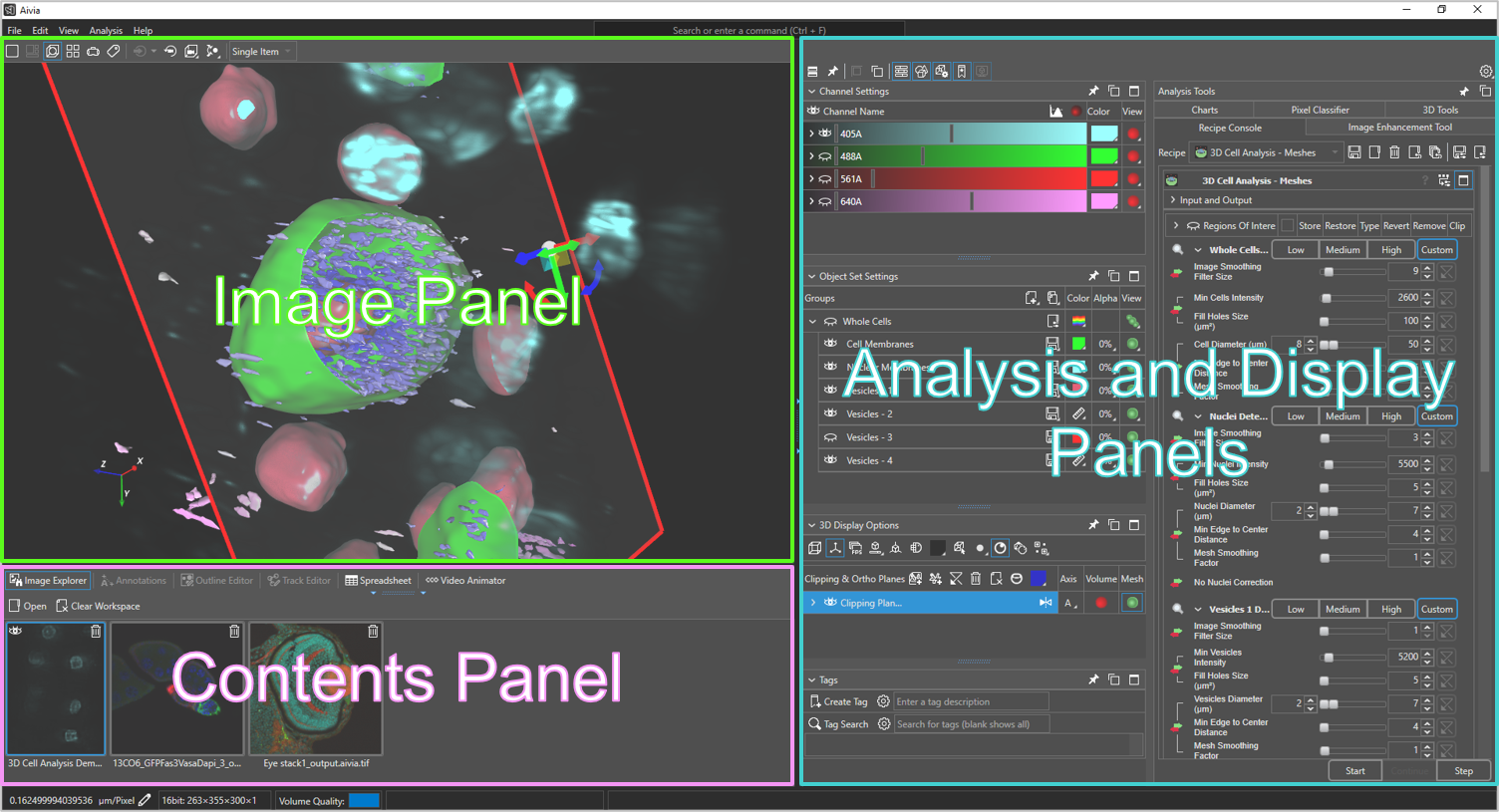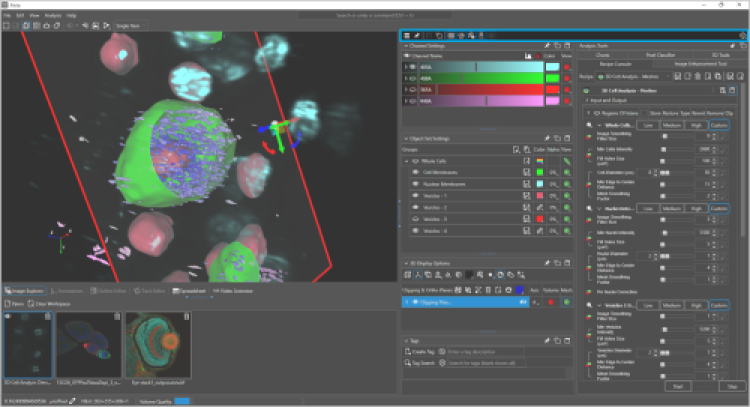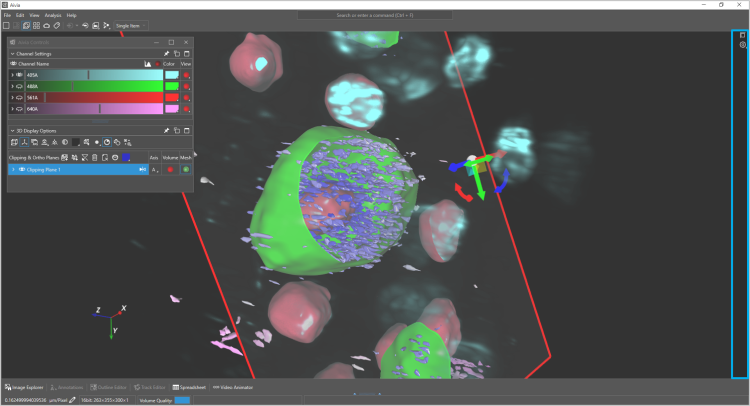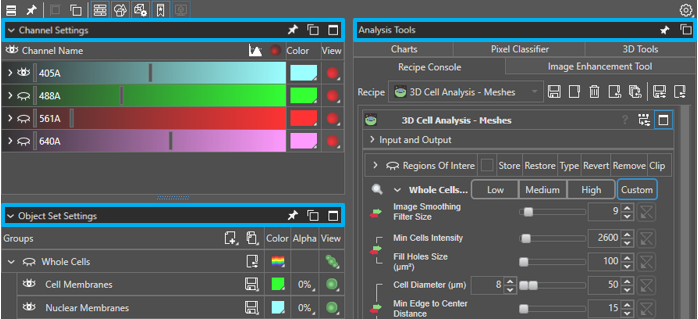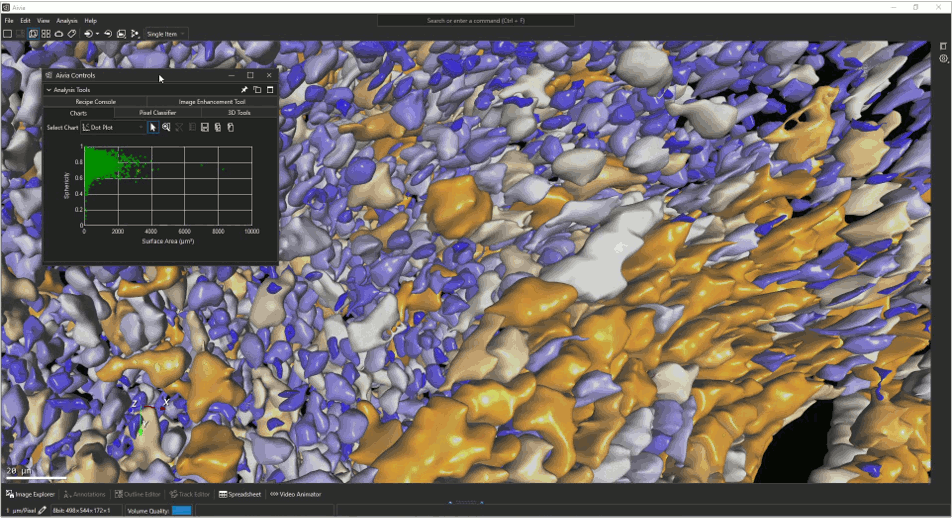Aivia Software
Graphical user interface
Image Panel
The Image Panel is the primary area for displaying the field of view (FOV) of the image and objects contained within the image. The Image Panel provides zoom control buttons for manipulating the display of the FOV in the zoombar. There are six (6) modes of display that can be accessed via the zoombar:
- Main View (2D View) shows the displayed image in 2D; for multi-dimensional images, you can navigate to a different time point (t-frame) or plane (z-frame) using the T and/or Z bar(s) below the image.
- Gallery View allows you to examine individual 2D objects in a thumbnail gallery.
- 3D View shows the displayed image in 3D; this option is only available when there is more than one z-plane on the image.
- 3D Plane View shows an xy-, yz-, and xz-plane of the image as well as a 3D view simultaneously; this option is only available when there is more than one z-plane on the image.
- VR View shows the displayed image in Virtual Reality (VR) space; while this mode is active, you will not be able to interact with the displayed image in the Image Panel.
- Classifier View lets you create and apply custom classification to analyzed data (objects).
You can interact with the image directly by moving your mouse cursor to the image and using the mouse to manipulate the display. For more information, please refer to the document on mouse interactions.
Contents Panel
The Contents Panel consists of several major features for displaying contents, editing analysis data, and exporting videos. It can be resized vertically by dragging the blue dotted handle near the top middle of the panel or collapsed/expanded by clicking once on the same handle. Alternately, you can open the panel by clicking on the button for a specific tool to open that particular feature. Some features are unavailable in different view modes.
There are six (6) tools in the Contents Panel:
- The Image Explorer displays thumbnails of the images you have loaded into Aivia and lets you switch between the loaded files
- The Annotations tool provides a set of on-screen tools for manually measuring the displayed image in Main View (2D View).
- The Outline Editor lets you create and edit the outlines of select objects in Main View (2D View).
- The Track Editor lets you edit track objects, modifying the relationships between tracks and track points over time.
- The Spreadsheet displays the measurement data for objects and object sets.
- The Video Animator lets you create and export flythrough videos in 3D View by capturing individual keyframes containing information about the current display.
Analysis and Display Panels
The primary tools for controlling the display of channels, objects, and other display overlays on the image are found in the following display settings panels:
- The Channel Settings panel lets you adjust the visibility, contrast, brightness, color, and rendering mode of the channels on the loaded image.
- The Object Set Settings panel lets you adjust the visibility, color, and display style of objects and tracks on the loaded image.
- The 3D Display Options panel lets you control how the 3D scene appears in the Image Panel; this panel includes a section for clipping planes and ortho planes.
- The Clipping & Ortho Planes section lets you add clipping planes or ortho slices to the 3D display to hide parts of the rendered volume or objects.
- The Tags panel lets you create, edit, and adjust the visibility of tags, which are customizable labels with notes for locations of interest in the image.
The (Pre-version 12) Analysis Panel consists of several tools for analyzing the displayed image—automatically via recipes or manually through editing. Depending on the view mode, different tools may be available.
There are five (5) tools within the Analysis Panel:
- The Recipe Console is the tool displayed by default; the Recipe Console allows you to select and apply an automated image processing and analysis pipeline (called a "recipe") to an image.
- The Image Enhancement Tool allows you to select and run an image processing pipeline to enhance an image.
- The Charts tab lets you plot analysis results graphically with a variety of display options.
- The Pixel Classifier lets you enhance an image using DRVISION's patented machine learning technology for content-aware enhancement of image features.
- The 3D Tools include a suite of functions for manually editing and generating analysis results as well as manipulating the display in 3D View.
Panel viewing controls
You may resize the Image Panel, Contents Panel, and any of the Analysis and Display Panels using the blue dotted handles. Click on the blue dotted handles that have blue arrows to hide/reveal panels.
The Analysis and Display Panels can be hidden and shown, collapsed and expanded, pinned and unpinned, and docked and popped out into floating windows with the global panel controls as well as controls found in the header of each panel.
Global panel controls
The global panel controls are found at the top of the Analysis and Display Panels section when panels are docked and along the right side of the Aivia window when all panels are in floating windows or not selected for display.
| Global panel controls with docked panels | Global panel controls with all floating panels and/or panels that are not displayed |
A description of each global panel control is given in the table below.
| Name | Icon | Description |
|---|---|---|
| Expand/Collapse All Panels | / | Expands/Collapses all panels that are not pinned |
| Unpin All Panels | Unpin all panels so that they appear in a single column in the main Aivia window and/or floating Aivia Controls window(s) | |
| Dock All Floating Panels | Dock all panels in floating windows to the main Aivia window | |
| Pop Out All Panels to Floating Windows | Pop all panels in the main Aivia window to floating Aivia Controls windows | |
| Expand/Collapse/Maximize Channel Settings | Expands/Collapses (when left-clicked) and maximizes (when middle-clicked) the Channel Settings panel; the icon is outlined in blue when the Channel Settings panel is expanded and is grayed out when the Channel Settings panel is pinned or in a floating window | |
| Expand/Collapse/Maximize Object Set Settings | Expands/Collapses (when left-clicked) and maximizes (when middle-clicked) the Object Set Settings panel; the icon is outlined in blue when the Object Set Settings panel is expanded and is grayed out when the Object Set Settings panel is pinned or in a floating window | |
| Expand/Collapse/Maximize 3D Display Options | Expands/Collapses (when left-clicked) and maximizes (when middle-clicked) the 3D Display Options panel; the icon is outlined in blue when the 3D Display Options panel is expanded and is grayed out when the 3D Display Options panel is pinned or in a floating window | |
| Expand/Collapse/Maximize Tags Panel | Expands/Collapses (when left-clicked) and maximizes (when middle-clicked) the Tags panel; the icon is outlined in blue when the Tags panel is expanded and is grayed out when the Tags panel is pinned or in a floating window | |
| Expand/Collapse/Maximize Analysis Tools | Expands/Collapses (when left-clicked) and maximizes (when middle-clicked) the Analysis Tools panel; the icon is outlined in blue when the Analysis Tools panel is expanded and is grayed out when the Analysis Tools panel is pinned or in a floating window | |
| Open Advanced GUI Options | Opens a menu where you can save and load your preferred GUI layouts as well as toggle on and off the display of each Analysis and Display Panel |
Saving and restoring layouts
Your preferred layouts of the Aivia GUI can be saved and restored as layout presets. Click on the Open Advanced GUI Options icon to open a menu where you can save, restore, rename, and remove layout presets (see diagram below).
| Layout preset options |
Toggling panel display
To remove or restore the display of any Analysis and Display Panel, click on the Open Advanced GUI Options icon and then on the name of the panel you wish to hide or show in the Displayed Items column. Panels that are displayed are outlined in blue in the Displayed Items column.
Panel header controls
The panel header controls for each panel are found in the same box as the panel name (see figure below). The panel header controls apply only to the associated panel.
| Panel headers |
Each option in the panel header is described in the table below. Some options are not available in certain layouts.
| Name | Icon | Description |
|---|---|---|
| Expand/Collapse Panel | / | Expands/Collapses the panel; when a panel is collapsed, the panel header is all that is shown of the panel |
| Pin/Unpin Panel | / | Pins/Unpins the panel; pinning a panel gives the panel its own column to the right of any unpinned panels |
| Pop Out Panel to Floating Window | Pops the panel out into a floating Aivia Controls window | |
| Maximize Panel | Maximizes the panel, collapsing all other panels in the same column |
Docking and undocking panels by drag and drop
| Docking a panel to the main Aivia window by drag and drop |
You can left-click and drag a panel header away from the main Aivia window or a floating Aivia Controls window and then drop the panel to move it to its own floating window. To dock a panel, you can left-click and drag the panel header to the Analysis and Display Panels region in the main Aivia window or to a floating Aivia Controls window, wait until the region turns blue and the docking icon appears, and then drop the panel to dock it in that location (see example above). You can dock all panels in a floating window by dragging the header of the Aivia Controls window. You can also return all panels in an Aivia Controls window to the main Aivia window by clicking on the 'X' in the upper-right corner of the Aivia Controls window.
